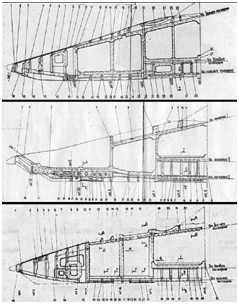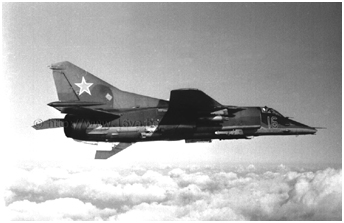
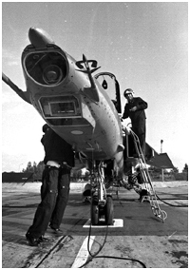 Fighter-bomber units experienced many upheavals beginning in the mid-1970s and especially during the 1980s.
Fighter-bomber units experienced many upheavals beginning in the mid-1970s and especially during the 1980s.
Besides the particular case of the 35.APIB based at Zerbst studied in the previous page, three units had their aircraft replaced by different versions of the MiG-27 "Flogger"
(19.Gv, 296. and 559.IBAP/APIB), three others received different models of the Su-17 "Fitter" (20.Gv, 497. and 730.APIB), two regiments were turned into bomber units on Su-24 "Fencer"
(116.Gv and 497.APIB), a new MiG-27 unit joined the GDR (911.APIB) and, finally, "Shturmoviks" came back with Su-25 "Frogfoot" (357. and 368.OChAP)!
| ORBAT 1976 - 1994 |
"Utkonos"
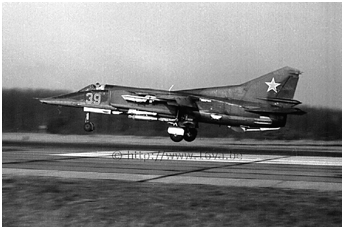
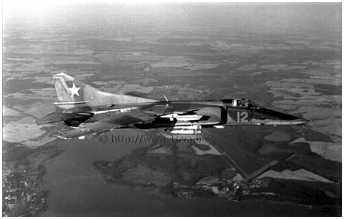 The first MiG-27 "Flogger-D" were identified in Finsterwalde in the spring of 1975, where they started to replace the Su-7BM "Fitter-A" of the 559.IBAP.
At that time, the 722.IBAP of Smuravevo previously equipped with MiG-23B and BN had become the first regiment to be equipped with MiG-27 and it was just beginning to tame the new jet
suffering from many teething problems.
A year later, it was the turn of the 19.GvIBAP to re-equip its first squadron with MiG-27 "without suffix" while the other two squadrons started their conversion to "Flogger-D"
in the summer of 1977. On the other hand, the 296.APIB received its first MiG-27 at the end of 1983. They were a dozen aircraft from the 19.GvAPIB which was then beginning to get
MiG-27D for its second and third squadrons. Note that the 1984 USMLM Unit History report mentioned the arrival of "Flogger-D" and "Flogger D/J Mod" in Altenburg that year.
This last designation was about the MiG-27D (Product 32-27) and M (Product 32-29) before they received the specific designation "Flogger-J" common to both models.
Some of the "Flogger D/J Mod" came from Krzywa's 3.APIB in Poland, which had its MiG-27 replaced by Su-24, thus effectively becoming a bomber unit, i.e. the 3.BAP.
Although obviously based on the airframe of the MiG-23 fighter, the dedicated ground attack versions of the "Flogger" had been thought only
for this task.
The first MiG-27 "Flogger-D" were identified in Finsterwalde in the spring of 1975, where they started to replace the Su-7BM "Fitter-A" of the 559.IBAP.
At that time, the 722.IBAP of Smuravevo previously equipped with MiG-23B and BN had become the first regiment to be equipped with MiG-27 and it was just beginning to tame the new jet
suffering from many teething problems.
A year later, it was the turn of the 19.GvIBAP to re-equip its first squadron with MiG-27 "without suffix" while the other two squadrons started their conversion to "Flogger-D"
in the summer of 1977. On the other hand, the 296.APIB received its first MiG-27 at the end of 1983. They were a dozen aircraft from the 19.GvAPIB which was then beginning to get
MiG-27D for its second and third squadrons. Note that the 1984 USMLM Unit History report mentioned the arrival of "Flogger-D" and "Flogger D/J Mod" in Altenburg that year.
This last designation was about the MiG-27D (Product 32-27) and M (Product 32-29) before they received the specific designation "Flogger-J" common to both models.
Some of the "Flogger D/J Mod" came from Krzywa's 3.APIB in Poland, which had its MiG-27 replaced by Su-24, thus effectively becoming a bomber unit, i.e. the 3.BAP.
Although obviously based on the airframe of the MiG-23 fighter, the dedicated ground attack versions of the "Flogger" had been thought only
for this task.
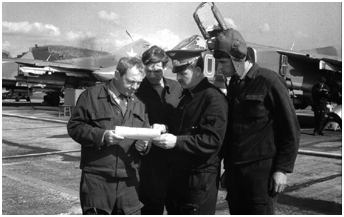
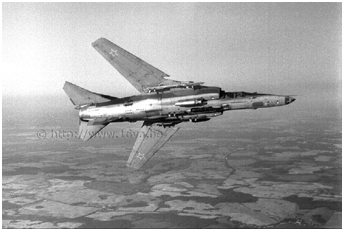 The first of them was the MiG-23B "Flogger-F" (Product 32-24) powered by a Lyul'ka AL-21F reactor of 7800 kgp dry and 8900 kgp with afterburner.
Besides three prototypes, only 24 copies were manufactured in 1972 due to the lack of AL-21F engines which also powered the Su-17 and the Su-24.
It was followed by the MiG-23BN "Flogger-H" (Product 32-24B) powered by an R29B-300 reactor. This engine with a dry thrust of 8300 kgp and 11500 kgp with afterburner was suitable for low altitude flight.
624 "Flogger-F" were produced at factory n°30 Znamya Truda between 1974 and 1985, mainly for export.
In the East German air force, this type of aircraft was in service with the JBG-37 "Klement Gottwald" based in Drewitz (> Link).
The equipment and payload of the MiG-23B and BN were similar. Up to three tons of loads could be fixed under seven hardpoints: a central one under the belly, two under the front fuselage (n°1 and 2),
two under the wing gloves (n°3 and 4) and two under the rear fuselage (n°5 and 6 - for bombs of 250 kg maximum or booster rockets) (> Link).
Two additional hardpoints for PTB-800 tanks were located under the wings set at the minimum deflection of 16° as on all MiG-23 equipped with a type 3 wing.
The first of them was the MiG-23B "Flogger-F" (Product 32-24) powered by a Lyul'ka AL-21F reactor of 7800 kgp dry and 8900 kgp with afterburner.
Besides three prototypes, only 24 copies were manufactured in 1972 due to the lack of AL-21F engines which also powered the Su-17 and the Su-24.
It was followed by the MiG-23BN "Flogger-H" (Product 32-24B) powered by an R29B-300 reactor. This engine with a dry thrust of 8300 kgp and 11500 kgp with afterburner was suitable for low altitude flight.
624 "Flogger-F" were produced at factory n°30 Znamya Truda between 1974 and 1985, mainly for export.
In the East German air force, this type of aircraft was in service with the JBG-37 "Klement Gottwald" based in Drewitz (> Link).
The equipment and payload of the MiG-23B and BN were similar. Up to three tons of loads could be fixed under seven hardpoints: a central one under the belly, two under the front fuselage (n°1 and 2),
two under the wing gloves (n°3 and 4) and two under the rear fuselage (n°5 and 6 - for bombs of 250 kg maximum or booster rockets) (> Link).
Two additional hardpoints for PTB-800 tanks were located under the wings set at the minimum deflection of 16° as on all MiG-23 equipped with a type 3 wing.
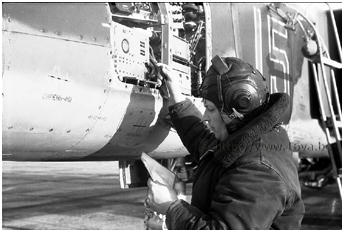
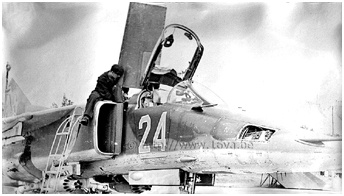 The 100 kg bombs could be suspended under multiple MBD2-67U bomb racks able to carry four of them, that is to say a total of 16 bombs under hardpoints n°1 to 4.
The MBD3-2UT-1 bomb racks could carry two 250 or 500 kg bombs under hardpoints n°3 and 4, i.e. 4 bombs.
The classic range of unguided S-5 rockets were fired from UB-16-57 or UB-32A pods, while the S-8 rockets required the carriage of B-8M1 rocket launchers.
A large-caliber S-24 rocket could be hung under each main hardpoint (n°1 to 4) (> Link).
The aircraft could carry a 30kt RN-40 nuclear bomb fixed under a dedicated BD3-66-23N pylon attached to hardpoint n°1 or n°2 under the fuselage.
As an example, the JBG-37 had 21 such pylons.
Moreover, all of the unit's MiG-23BN - as well as the Bulgarian and Czechoslovakian MiG-23BN - were wired and equipped with the dedicated control panels for the carriage of nuclear weapons
(nuclear control panel to the right of the image here > Link).
The "Floggers" were also equipped with a PBK-3 sight for toss bombing.
In addition to the GSh-23L belly cannon inherited from the fighter version, it was possible to increase the firepower by adding two UPK-23-250 canon pods supplied with 250 rounds of ammunition
(> Link) attached under hardpoints n°3 and 4. In addition, the MiG-23B/BN were capable of firing Kh-23 and Kh-23M air-to-surface missiles
(> Link).
The 100 kg bombs could be suspended under multiple MBD2-67U bomb racks able to carry four of them, that is to say a total of 16 bombs under hardpoints n°1 to 4.
The MBD3-2UT-1 bomb racks could carry two 250 or 500 kg bombs under hardpoints n°3 and 4, i.e. 4 bombs.
The classic range of unguided S-5 rockets were fired from UB-16-57 or UB-32A pods, while the S-8 rockets required the carriage of B-8M1 rocket launchers.
A large-caliber S-24 rocket could be hung under each main hardpoint (n°1 to 4) (> Link).
The aircraft could carry a 30kt RN-40 nuclear bomb fixed under a dedicated BD3-66-23N pylon attached to hardpoint n°1 or n°2 under the fuselage.
As an example, the JBG-37 had 21 such pylons.
Moreover, all of the unit's MiG-23BN - as well as the Bulgarian and Czechoslovakian MiG-23BN - were wired and equipped with the dedicated control panels for the carriage of nuclear weapons
(nuclear control panel to the right of the image here > Link).
The "Floggers" were also equipped with a PBK-3 sight for toss bombing.
In addition to the GSh-23L belly cannon inherited from the fighter version, it was possible to increase the firepower by adding two UPK-23-250 canon pods supplied with 250 rounds of ammunition
(> Link) attached under hardpoints n°3 and 4. In addition, the MiG-23B/BN were capable of firing Kh-23 and Kh-23M air-to-surface missiles
(> Link).
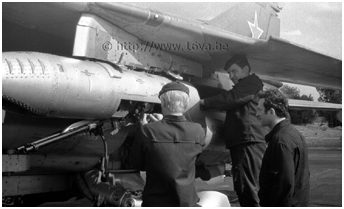
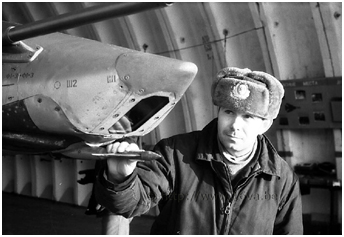 The pilot steered these with a joystick mounted on the control column via a Del'ta-N and later -NM radio guidance system housed in a pointed fairing fixed under the wing glove on the right,
as on the MiG-23UB. Two R-3S or R-13M missiles with IR guidance were likely to occupy hardpoints n°1 and 2 for self-defense.
The implementation of all this armament was possible thanks to the navigation and attack system Sokol-23N (hence the MiG-23BN designation) associated with an ASP-17B optical sight, a
S-17VG-1 HUD and a Fon (Background) (> Link) laser rangefinder hidden behind a slanted window below the lower part of the nose tip.
The latter, with a range of 4 km, could not
designate a target. Just above, forming the tip, was the receiving antenna of the SPS-141M or 142 Siren'-FSh (Lilac) jammer whose transmitting antennas were housed
in two side fairings located on either side of the nose. An SPO-10 Sirena-3M radar warning receiver was also present.
The pilot steered these with a joystick mounted on the control column via a Del'ta-N and later -NM radio guidance system housed in a pointed fairing fixed under the wing glove on the right,
as on the MiG-23UB. Two R-3S or R-13M missiles with IR guidance were likely to occupy hardpoints n°1 and 2 for self-defense.
The implementation of all this armament was possible thanks to the navigation and attack system Sokol-23N (hence the MiG-23BN designation) associated with an ASP-17B optical sight, a
S-17VG-1 HUD and a Fon (Background) (> Link) laser rangefinder hidden behind a slanted window below the lower part of the nose tip.
The latter, with a range of 4 km, could not
designate a target. Just above, forming the tip, was the receiving antenna of the SPS-141M or 142 Siren'-FSh (Lilac) jammer whose transmitting antennas were housed
in two side fairings located on either side of the nose. An SPO-10 Sirena-3M radar warning receiver was also present.
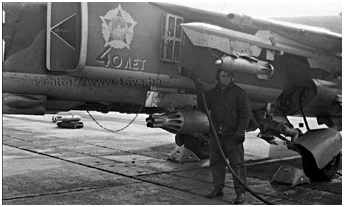
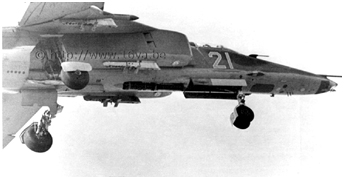 At the end of 1972, a new prototype designated MiG-23BM (M for "modernized") developed from the MiG-23B made its first flight. The development of this modification would give rise to the aircraft
usually designated MiG-27 "Flogger-D" (Product 32-25). In fact MiG-23BM and MiG-27 are one and the same aircraft. The MiG-27 designation would have been adopted by the VVS after
the certification of the plane in 1975. The motorization of the newcomer was provided by a R29B-300 engine like the MiG-23BN. But while the external appearance of the MiG-27 was very similar to that of the
MiG-23BN with which it shared the reactor, it was however here that the identification of one or the other version was decisive. The MiG-23B and BN had variable geometry air intakes, hence the large
splitter plates in front of them, as on the fighter versions, while the MiG-27 had fixed air intakes. As a consequence of this, the maximum speed was reduced from
Mach 2.35 to Mach 1.7, which was not a problem given the profile of the missions. However, the MiG-27's air intakes were slightly larger.
Another difference was clearly apparent on the ground: the MiG-27 did not have the high nose-up attitude of the MiG-23B and BN due to the tilting of its main undercarriage 175 mm downwards permitting a faster
acceleration on take-off thanks to the consecutive aerodynamic drag reduction.
Also, the main landing gear wheels were larger to facilitate operations from semi-prepared ground.
At the end of 1972, a new prototype designated MiG-23BM (M for "modernized") developed from the MiG-23B made its first flight. The development of this modification would give rise to the aircraft
usually designated MiG-27 "Flogger-D" (Product 32-25). In fact MiG-23BM and MiG-27 are one and the same aircraft. The MiG-27 designation would have been adopted by the VVS after
the certification of the plane in 1975. The motorization of the newcomer was provided by a R29B-300 engine like the MiG-23BN. But while the external appearance of the MiG-27 was very similar to that of the
MiG-23BN with which it shared the reactor, it was however here that the identification of one or the other version was decisive. The MiG-23B and BN had variable geometry air intakes, hence the large
splitter plates in front of them, as on the fighter versions, while the MiG-27 had fixed air intakes. As a consequence of this, the maximum speed was reduced from
Mach 2.35 to Mach 1.7, which was not a problem given the profile of the missions. However, the MiG-27's air intakes were slightly larger.
Another difference was clearly apparent on the ground: the MiG-27 did not have the high nose-up attitude of the MiG-23B and BN due to the tilting of its main undercarriage 175 mm downwards permitting a faster
acceleration on take-off thanks to the consecutive aerodynamic drag reduction.
Also, the main landing gear wheels were larger to facilitate operations from semi-prepared ground.
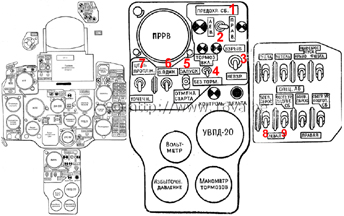
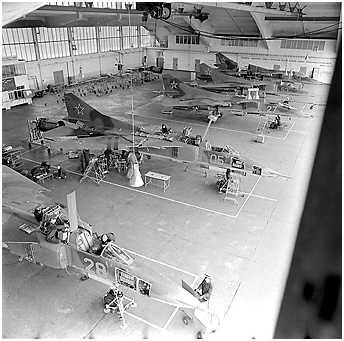 A new PrNK-23 digital attack and navigation system replaced the Sokol. The set included an Orbita-10-15-23 digital computer, a KN-23 navigation complex (which could serve as a backup in case of computer failure),
and still the S-17VG-1 HUD, the ASP-17B sight and the Fon laser rangefinder.
The bombardment was possible in horizontal flight, in a dive or in a resource and in particular on invisible pre-programmed targets.
The same number of hardpoints was kept. However, positions n°1 and 2 were shifted from under the fuselage to under the air intakes. Furthermore, the DZU-1 locks of the hardpoints located on the rear fuselage
were replaced during production by DZU-1A models allowing the attachment of 500 kg instead of 250 kg bombs.
A new PrNK-23 digital attack and navigation system replaced the Sokol. The set included an Orbita-10-15-23 digital computer, a KN-23 navigation complex (which could serve as a backup in case of computer failure),
and still the S-17VG-1 HUD, the ASP-17B sight and the Fon laser rangefinder.
The bombardment was possible in horizontal flight, in a dive or in a resource and in particular on invisible pre-programmed targets.
The same number of hardpoints was kept. However, positions n°1 and 2 were shifted from under the fuselage to under the air intakes. Furthermore, the DZU-1 locks of the hardpoints located on the rear fuselage
were replaced during production by DZU-1A models allowing the attachment of 500 kg instead of 250 kg bombs.
 Deux manières d'effectuer un bombardement en ressource illustrées dans une salle de classe du 19.GvAPIB. © Y.Rodine.
Deux manières d'effectuer un bombardement en ressource illustrées dans une salle de classe du 19.GvAPIB. © Y.Rodine.
Two ways to perform a LABS attack illustrated in a classroom of the 19.GvAPIB. © Y.Rodin.
Thus, a MiG-27 could carry eight 500 kg bombs: one under each hardpoint n°1, 2, 5 and 6 and two under hardpoints
n°3 and 4 attached to MBD3-2UT-1 pylons. Consequently, the maximum weight of the weapons load increased from 3000 to 4000 kg, which was the same load as with the Su-17M4.
The weapons range which also included KMGU sub-munitions dispensers included the Kh-25MR air-to-surface missile (as on some production batches of the MiG-23BN), while the guidance system was upgraded to the Del'ta-2NG
- on the MiG-27, its fairing was in the leading edge of the right wing, rather than under it.
The MiG-27 was, of course, nuclear capable, but it was special in that each example, including those of the later versions studied afterwards, was equipped by default with the wiring and control panels necessary for
carrying out special missions. The main control panel was located behind the control column, between the pilot's legs at the bottom and a switch console was mounted forward, at the bottom of the right cockpit side wall.
The nuclear bomb was attached under hardpoint n°1 or n°2 (296.APIB special mission > Link).
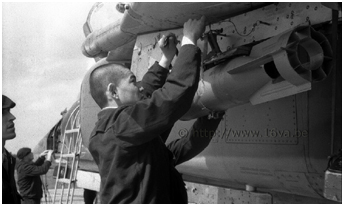
 The GSh-23L cannon was replaced by a GSh-6-30A 30mm cannon derived from a naval weapon.
Its rate of fire could reach 5500/6100 rounds per minute and its magazine contained 300 shells. With such a firepower and a recoil of no less than 5500 kg, its adaptation to the MiG-27 was not without problems, the weapon
being able to cause damage to the aircraft itself. One of the measures taken to remedy the problems was to mount two vertical fences on either side of the cannon muzzle.
Also, two UPK-23-250 cannon pods or two SPPU-22-01 containers could be placed under hardpoints n°3 and 4. The SPPU-22-01 housed a GSh-23L cannon that could swivel downwards up to an angle of 30°.
In addition to the Kh-23, Kh-23M and Kh-25MR missiles, it was planned that the MiG-27 could carry the Kh-28 (AS-9 "Kyle") anti-radar missile under the right wing, while a Metel'-A (Blizzard) pod
for the detection and the identification of radar emissions was mounted under the left wing. However, this large missile did not enter service with the MiG-27 units and the equipment already mounted were removed from the planes.
The SPO-10 radar warning receiver was supplemented by an SB-1 Bar'yer (Barrier) system for detecting and locating radars working in the forward hemisphere mounted in the nose.
However, it was installed only in the first series aircraft because it did not give satisfaction and its dielectric panel was replaced by a metal sheet.
In addition to the SPS-141M/142 ECM complex, two KDS-23 decoy launcher cassettes containing six cartridges each (thermal PPI-50 or dipole reflectors PRP-50) were housed flush, on the back of the central fuselage section.
Another cassette was housed in the center pylon - the belly tank had to be be jettisoned before firing the decoys.
The GSh-23L cannon was replaced by a GSh-6-30A 30mm cannon derived from a naval weapon.
Its rate of fire could reach 5500/6100 rounds per minute and its magazine contained 300 shells. With such a firepower and a recoil of no less than 5500 kg, its adaptation to the MiG-27 was not without problems, the weapon
being able to cause damage to the aircraft itself. One of the measures taken to remedy the problems was to mount two vertical fences on either side of the cannon muzzle.
Also, two UPK-23-250 cannon pods or two SPPU-22-01 containers could be placed under hardpoints n°3 and 4. The SPPU-22-01 housed a GSh-23L cannon that could swivel downwards up to an angle of 30°.
In addition to the Kh-23, Kh-23M and Kh-25MR missiles, it was planned that the MiG-27 could carry the Kh-28 (AS-9 "Kyle") anti-radar missile under the right wing, while a Metel'-A (Blizzard) pod
for the detection and the identification of radar emissions was mounted under the left wing. However, this large missile did not enter service with the MiG-27 units and the equipment already mounted were removed from the planes.
The SPO-10 radar warning receiver was supplemented by an SB-1 Bar'yer (Barrier) system for detecting and locating radars working in the forward hemisphere mounted in the nose.
However, it was installed only in the first series aircraft because it did not give satisfaction and its dielectric panel was replaced by a metal sheet.
In addition to the SPS-141M/142 ECM complex, two KDS-23 decoy launcher cassettes containing six cartridges each (thermal PPI-50 or dipole reflectors PRP-50) were housed flush, on the back of the central fuselage section.
Another cassette was housed in the center pylon - the belly tank had to be be jettisoned before firing the decoys.

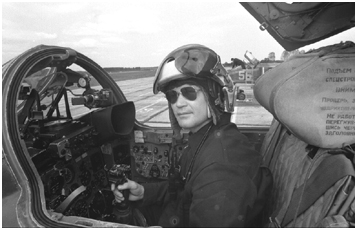 The pictures of MiG-27 of the 16.VA all show that the aircraft were equipped with the SRO-2M Khrom Nikel' IFF system that easily could be identified by three small antennas of decreasing size located under their nose.
However, a pilot's manual from 1979 about the Product 32-25 mentions both the SRO-2M and the SRO-1P - the latter had a triangular shaped antenna (1). The SRO-1P was fitted to
the MiG-27K studied below. The MiG-27 was susceptible to stall depending on its angle of attack relative to a given flight regime. This could also affect the proper functioning of the reactor. This is why the pilot had
an UUA-1A needle angle of attack indicator well located in his field of vision to the left of the HUD or against the windshield frame, also at left.
Two flashing lamps fixed on either side of the HUD warned the pilot when he was approaching the critical angle. But other automatic control systems were added over time like a mechanism that pushed the control column
forward when necessary.
The lack of a radar on the ground-attack versions of the MiG-23 had allowed the pilot's downward visibility to be increased by giving a steep slope over the nose,
earning them the nickname Utkonos (literally duck nose - another nickname was "Gena the Crocodile," a popular comic book character).
A total of 360 MiG-27 were manufactured in Irkutsk between 1973 and 1977.
The pictures of MiG-27 of the 16.VA all show that the aircraft were equipped with the SRO-2M Khrom Nikel' IFF system that easily could be identified by three small antennas of decreasing size located under their nose.
However, a pilot's manual from 1979 about the Product 32-25 mentions both the SRO-2M and the SRO-1P - the latter had a triangular shaped antenna (1). The SRO-1P was fitted to
the MiG-27K studied below. The MiG-27 was susceptible to stall depending on its angle of attack relative to a given flight regime. This could also affect the proper functioning of the reactor. This is why the pilot had
an UUA-1A needle angle of attack indicator well located in his field of vision to the left of the HUD or against the windshield frame, also at left.
Two flashing lamps fixed on either side of the HUD warned the pilot when he was approaching the critical angle. But other automatic control systems were added over time like a mechanism that pushed the control column
forward when necessary.
The lack of a radar on the ground-attack versions of the MiG-23 had allowed the pilot's downward visibility to be increased by giving a steep slope over the nose,
earning them the nickname Utkonos (literally duck nose - another nickname was "Gena the Crocodile," a popular comic book character).
A total of 360 MiG-27 were manufactured in Irkutsk between 1973 and 1977.
| MiG-27 NATO designations | ||
|---|---|---|
| Types | Final | Early |
| Article 32-24 MiG-23B | Flogger-F | |
| Article 32-24B MiG-23BN | Flogger-H | |
| Article 32-25 MiG-23BM / MiG-27 | Flogger-D | |
| Article 32-26 MiG-23BK / MiG-27K | Flogger-J2 | Flogger-J |
| Article 32-27 MiG-27D | Flogger-J | Flogger-D/J Mod |
| Article 32-29 MiG-27M | Flogger-J | Flogger-D/J Mod |
"Kayra"
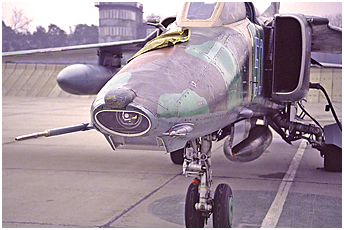
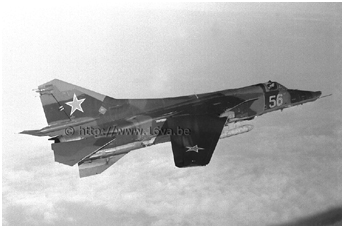 The following MiG-27 version adopted by the VVS was the MiG-27K (Product 32-26) initially designated "Flogger-J" in the West and finally "Flogger-J2."
It was based on an experimentally modified MiG-23BM called MiG-23BK that first flew on December 30, 1974. The latter would give rise to the most successful version of all the MiG-27 variants,
capable of carrying out its attacks both at night and in bad weather with new laser-guided precision weapons and anti-radar missiles.
This new aircraft stood out thanks to an innovative target acquisition and tracking complex based on a TV channel associated with a laser developed by the "Geofizika" Central Design Bureau in Moscow
to equip the Su-24 as well as the MiG-27. The new MiG-23BK, alias MiG-27K, took its suffix K from the baptismal name Kayra very opportunely given to the complex. The Guillemot (Kayra) is
indeed a bird capable of flying looking backwards, just like the MiG-27K that could continue to designate its target while flying away!
The principle of operation consisted of a TV camera ensuring the identification and tracking of the target, associated with a laser channel acting as a rangefinder and target designator.
The TV optics (vidicon tube) provided a high resolution image converted into electrical signals. The pilot could switch between a 40 or 140 mm lens. The "Kayra-23" TV channel displayed a contrast-enhanced image
on the IT-23 (later IT-23M) console in the cockpit, making target identification possible in poor light conditions.
The following MiG-27 version adopted by the VVS was the MiG-27K (Product 32-26) initially designated "Flogger-J" in the West and finally "Flogger-J2."
It was based on an experimentally modified MiG-23BM called MiG-23BK that first flew on December 30, 1974. The latter would give rise to the most successful version of all the MiG-27 variants,
capable of carrying out its attacks both at night and in bad weather with new laser-guided precision weapons and anti-radar missiles.
This new aircraft stood out thanks to an innovative target acquisition and tracking complex based on a TV channel associated with a laser developed by the "Geofizika" Central Design Bureau in Moscow
to equip the Su-24 as well as the MiG-27. The new MiG-23BK, alias MiG-27K, took its suffix K from the baptismal name Kayra very opportunely given to the complex. The Guillemot (Kayra) is
indeed a bird capable of flying looking backwards, just like the MiG-27K that could continue to designate its target while flying away!
The principle of operation consisted of a TV camera ensuring the identification and tracking of the target, associated with a laser channel acting as a rangefinder and target designator.
The TV optics (vidicon tube) provided a high resolution image converted into electrical signals. The pilot could switch between a 40 or 140 mm lens. The "Kayra-23" TV channel displayed a contrast-enhanced image
on the IT-23 (later IT-23M) console in the cockpit, making target identification possible in poor light conditions.
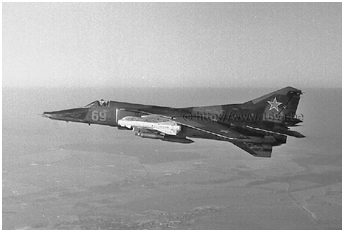
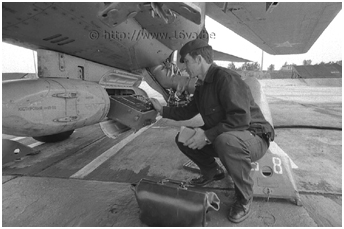 When a laser-guided weapon was in use, once the target had been identified and locked by the pilot, the Orbita 20-23K digital computer kept track of the target thanks to the gyrostabilized
prism common to the laser designator and the camera which could swivel 35° in azimuth and 160° downwards.
In the case of a TV-guided weapon, once the pilot had pinpointed the target, he activated the weapon's sensor which then displayed an image on the IT-23 screen. When the aiming point had been locked by the pilot,
the weapon could be released without the need for further interaction.
The "Flogger-J2" was thus suitable for firing a range of weapons extended to laser-guided projectiles such as the KAB-500L bomb initially developed for the MiG-27K (2).
The presence of the Kayra complex could be identified by a partially redesigned forward fuselage.
The receiving optic of the 9P laser rangefinder was housed in the nose tip, sheltered behind a round-shaped porthole. Consequently, the receiving antenna of the SPS-141M/142 ECM system was displaced and mounted
in a small bulb grafted onto the upper part of the nose cone. The 11S1 sighting unit comprising the TV camera and the laser rangefinder/target designator was chin mounted in a fairing fitted with
a rectangular porthole.
When a laser-guided weapon was in use, once the target had been identified and locked by the pilot, the Orbita 20-23K digital computer kept track of the target thanks to the gyrostabilized
prism common to the laser designator and the camera which could swivel 35° in azimuth and 160° downwards.
In the case of a TV-guided weapon, once the pilot had pinpointed the target, he activated the weapon's sensor which then displayed an image on the IT-23 screen. When the aiming point had been locked by the pilot,
the weapon could be released without the need for further interaction.
The "Flogger-J2" was thus suitable for firing a range of weapons extended to laser-guided projectiles such as the KAB-500L bomb initially developed for the MiG-27K (2).
The presence of the Kayra complex could be identified by a partially redesigned forward fuselage.
The receiving optic of the 9P laser rangefinder was housed in the nose tip, sheltered behind a round-shaped porthole. Consequently, the receiving antenna of the SPS-141M/142 ECM system was displaced and mounted
in a small bulb grafted onto the upper part of the nose cone. The 11S1 sighting unit comprising the TV camera and the laser rangefinder/target designator was chin mounted in a fairing fitted with
a rectangular porthole.

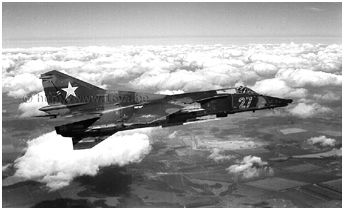 The S-17VG head-up display gave way to the IPP-2-53 model, while the Del'ta radio guidance system was no longer mounted on the MiG-27K and the outdated Kh-23/M and Kh-25MR missiles therefore required the carrying
of an external pod fixed under hardpoint n°2. The S-13 camera attached to the left wing root was also abandoned. However, the standard SSh-45 device that took pictures from the HUD at the time of aiming and firing
was retained. On the other hand, an FKP-58 pod containing a camera and a video recorder was frequently carried under the belly in order to immortalize the firing of air-to-ground missiles. The DZU-1A locks of the
rear fuselage bomb launchers were replaced by more advanced DZ-UM models. Logically, the increased capabilities of the MiG-27 were accompanied by an improved PrNK-23K weapons system with an A-321 short-range
navigation system (RSBN Korall-I) and an A-720 (RSDN-10 Skip-2) long-range navigation system.
Also, the SRO-2M Khrom IFF system gave way to the SRO-1P Parol'-2D complex. The root of the fixed part of the wing had been extended forward, forming a LERX ending shortly before the air intake
of the engines. These - common to the MiG-27D and M studied in the following page - were intended to receive in their front part antennas of the SPO-15L Beryoza-L (Birch) radar detection and warning system,
of which another antenna was located at the top of the vertical fin. In doing so, the LERX improved the handling qualities at high angles of attack - a flight configuration which presented a potential problem with the MiG-23
airframe.
The S-17VG head-up display gave way to the IPP-2-53 model, while the Del'ta radio guidance system was no longer mounted on the MiG-27K and the outdated Kh-23/M and Kh-25MR missiles therefore required the carrying
of an external pod fixed under hardpoint n°2. The S-13 camera attached to the left wing root was also abandoned. However, the standard SSh-45 device that took pictures from the HUD at the time of aiming and firing
was retained. On the other hand, an FKP-58 pod containing a camera and a video recorder was frequently carried under the belly in order to immortalize the firing of air-to-ground missiles. The DZU-1A locks of the
rear fuselage bomb launchers were replaced by more advanced DZ-UM models. Logically, the increased capabilities of the MiG-27 were accompanied by an improved PrNK-23K weapons system with an A-321 short-range
navigation system (RSBN Korall-I) and an A-720 (RSDN-10 Skip-2) long-range navigation system.
Also, the SRO-2M Khrom IFF system gave way to the SRO-1P Parol'-2D complex. The root of the fixed part of the wing had been extended forward, forming a LERX ending shortly before the air intake
of the engines. These - common to the MiG-27D and M studied in the following page - were intended to receive in their front part antennas of the SPO-15L Beryoza-L (Birch) radar detection and warning system,
of which another antenna was located at the top of the vertical fin. In doing so, the LERX improved the handling qualities at high angles of attack - a flight configuration which presented a potential problem with the MiG-23
airframe.
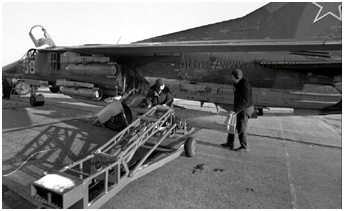
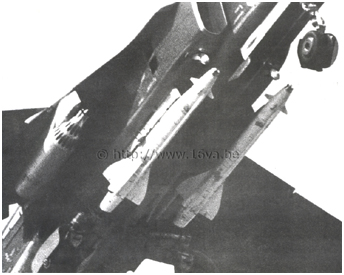
 The MiG-27K (as well as the D and M models) could self-defend itself using R-60M "AA-8B Aphid-B" infrared-guided missiles. The latter were generally attached to P-62-II rails - designed for the simultaneous carriage of
two missiles - that were attached under a BD3-UMK pylon at hardpoint n°3 or 4. It was possible to increase the number of flare launchers by adding two BVP-50-60 boxes on the back of the fuselage as was done in Afghanistan.
However, nothing like this has ever been observed on aircraft from the fighter-bomber units of the 16.VA.
The MiG-27K (as well as the D and M models) could self-defend itself using R-60M "AA-8B Aphid-B" infrared-guided missiles. The latter were generally attached to P-62-II rails - designed for the simultaneous carriage of
two missiles - that were attached under a BD3-UMK pylon at hardpoint n°3 or 4. It was possible to increase the number of flare launchers by adding two BVP-50-60 boxes on the back of the fuselage as was done in Afghanistan.
However, nothing like this has ever been observed on aircraft from the fighter-bomber units of the 16.VA.
But the beginnings were difficult. Considered too complicated for the average pilot, the development of the Kayra remained delicate at the beginning and its weight was too important.
This is how the side armor plates of the cockpit were sometimes dismantled as can be seen on several images illustrating this page.
A total of 197 MiG-27K were manufactured at the Plant n°39 plant in Irkutsk between 1976 and 1982. MiG-23UB also were produced there, while the MiG-27 were converted into MiG-27D there as we will see later.
Thus, some MiG-27K and MiG-27D have received an imitation canopy painted behind the cockpit in order to pass them off as two-seaters in the eyes of inquisitive satellites!
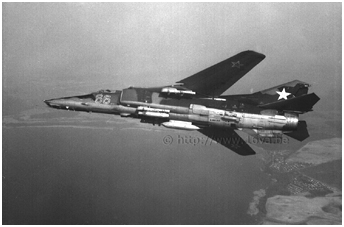
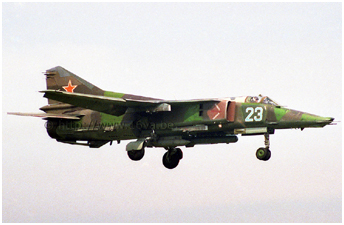 The first MiG-27K of the 16.VA joined the ranks of the first squadron of the 19.GvAPIB in 1980. The 1.AE of the 559.APIB received its first aircraft in March 1980 as seem to indicate an observation of the USMLM on March 3
(delivery of airframes in crates by an An-22) and, also, an observation of the MMFL on March 20 (photos of "Flogger-J").
The 1980 annual report of the USMLM History emphasized the significant increase in the re-equipment of the air units, whether with airplanes or attack helicopters.
It is thus specified that the number of "Floggers" (all types combined) increased from 325 to 503 units, while the "Fitter" saw their number increase from 165 to 229 units, i.e. an overall increase for both aircraft types
by 32%.
The first MiG-27K of the 16.VA joined the ranks of the first squadron of the 19.GvAPIB in 1980. The 1.AE of the 559.APIB received its first aircraft in March 1980 as seem to indicate an observation of the USMLM on March 3
(delivery of airframes in crates by an An-22) and, also, an observation of the MMFL on March 20 (photos of "Flogger-J").
The 1980 annual report of the USMLM History emphasized the significant increase in the re-equipment of the air units, whether with airplanes or attack helicopters.
It is thus specified that the number of "Floggers" (all types combined) increased from 325 to 503 units, while the "Fitter" saw their number increase from 165 to 229 units, i.e. an overall increase for both aircraft types
by 32%.
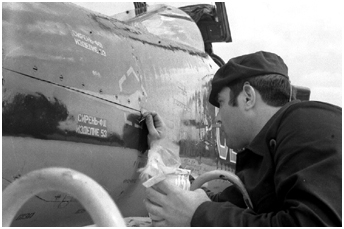
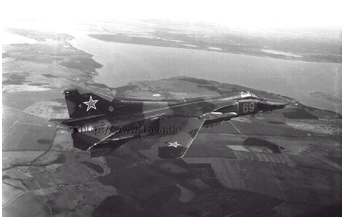 The same report mentioned an evolution in low-altitude attack tactics over firing ranges, pointing out that the perception of the "rigid and unimaginative" Soviet pilot was no longer relevant.
In 1987-88, the MiG-27K of Lärz and also aircraft of the 88.APIB, re-equipped the second and third squadrons of the 559.APIB. The case of Brand's 911.APIB is special, since it only joined the GDR from Lida in Belarus
in 1989 with only a squadron of MiG-27K, occupying the place left vacant by the 116.GvBAP which had moved to Ross, also in Belarus, with its Su-24M
(3)! The rest of the unit would have been completed with aircraft from the 16.VA. A new turning point in the units organization was indeed taken in 1989 when the
standard structure of the aviation regiments was reduced from 45 to 32 aircraft, generating a surplus of aircraft. The training two-seaters, in this case the MiG-23UB with regard to the units flying on MiG-27, were not
included in this count! We will also note the same year the decision of the Soviet Government to reduce its tactical nuclear arsenal, most of the MiG-27 still in service seeing the related equipment removed.
In addition, the BRIXMIS annual report for 1990 reported that from November 14, presumably under the "Conventional Forces in Europe" (CFE) agreements, the departure of about 80 aircraft including "Fitter," "Frogfoot" and
"Fulcrum" were observed without being the subject of a press announcement by the Soviet authorities.
The same report mentioned an evolution in low-altitude attack tactics over firing ranges, pointing out that the perception of the "rigid and unimaginative" Soviet pilot was no longer relevant.
In 1987-88, the MiG-27K of Lärz and also aircraft of the 88.APIB, re-equipped the second and third squadrons of the 559.APIB. The case of Brand's 911.APIB is special, since it only joined the GDR from Lida in Belarus
in 1989 with only a squadron of MiG-27K, occupying the place left vacant by the 116.GvBAP which had moved to Ross, also in Belarus, with its Su-24M
(3)! The rest of the unit would have been completed with aircraft from the 16.VA. A new turning point in the units organization was indeed taken in 1989 when the
standard structure of the aviation regiments was reduced from 45 to 32 aircraft, generating a surplus of aircraft. The training two-seaters, in this case the MiG-23UB with regard to the units flying on MiG-27, were not
included in this count! We will also note the same year the decision of the Soviet Government to reduce its tactical nuclear arsenal, most of the MiG-27 still in service seeing the related equipment removed.
In addition, the BRIXMIS annual report for 1990 reported that from November 14, presumably under the "Conventional Forces in Europe" (CFE) agreements, the departure of about 80 aircraft including "Fitter," "Frogfoot" and
"Fulcrum" were observed without being the subject of a press announcement by the Soviet authorities.
 |
MiG-23BN Pilot |  |
 |
911.APIB MiG-27K walk around |  |
| Pilot and photographer Most of the photographs illustrating this article were taken by Yuri Rodin. Yuri was a pilot of the 19.GvAPIB during the eighties. Rare were the soldiers who were able to document their service extensively, moreover with good quality photos. Photography was in principle prohibited and we do not know if he benefited from any indulgence. Be that as it may, his photographic testimony is exceptional and will be the subject of a later album. It is also interesting to retrace Yuri's journey through his successive assignments below. - 1975 / 1977: 266.IBAP at Nalaykh (Mongolia) - MiG-21PFM, MiG-21bis - 1977 / 1981: 58.APIB at Step' (Eastern Siberia) - MiG-23B - 12-1981 / 1986: 19.GvAPIB at Lärz - MiG-27, MiG-27K, MiG-27D - 1986: 88.APIB at Kanatovo (Ukraine) - MiG-27K - 1987 / 1990: 88.APIB at Debrecen (Hungary) - MiG-27D (88.APIB from Kanatovo to Debrecen - 727.GvBAP on Su-24 from Debrecen to Kanatovo) - 1990 / 1995: 88.OMAPIB at Olen'ya (Murmansk, Kola Peninsula) - MiG-27D (unit transferred to the Navy within the framework of CFE treaty) |
notes
(1)
The slow development of the SRO-1P Parol' system accelerated after V. Belenko defected to Japan with his MiG-25P on September 6, 1976.
However, photo evidence show that the MiG-27 of the 19.GvAPIB were devoided of it at least until 1984!
(2)
In addition to conventional bombs and unguided rockets up to 240mm, the MiG-27K could carry:
- KAB-500L laser-guided bombs
- Kh-25L and ML (AS-10 "Karen") and Kh-29L (AS-14 "Kedge") laser-guided missiles.
- KAB-500Kr TV-guided bombs.
- Kh-29T (AS-14 "Kedge") TV-guided missiles.
- A Del'ta-NG2 pod was attached under the right air intake to control Kh-23/M (AS-7 "Kerry") and Kh-25MR (AS-10 "Karen") radio-guided
missiles.
- A BA-58 V'youga (Blizzard) pod was attached under the right air intake to detect and identify the enemy radar emissions and relay the
information to Kh-25MP (AS-12 "Kegler") and Kh-27PS (AS-12 "Kegler") anti-radar missiles. It had to be configured before the flight.
- The Kh-31P (AS-17 "Krypton") ARM was tested from the mid-1980s. It was used in conjunction with a Progress designation pod.
However, the demise of the USSR did not permit its development for the MiG-27.
- An FKP-58 pod was sometimes attached under the belly of the MiG-27K to film the firing of air-to-ground missiles.
(3)
In July-August 1989, the reorganization generated by the political withdrawal of the Su-24 "Fencer" bombers from the 16.VA gave the MiG-27 its
peak in the Soviet Air Force based in Germany. This withdrawal was to lead to the displacement of no less than 5 regiments! The Su-24
"Fencer-B/-C" of the 497.BAP of Grossenhain were transferred to Lida in Belarus (where the unit was disbanded and its planes transferred to
Shatalovo), giving way to the MiG-27D and M of the 296.APIB from Altenburg, while the MiG-29 of the 968.IAP from Ross, also in Belarus, were
in turn moving towards Altenburg... Su-24M ofthe 116.GvBAP from Brand went to Ross, taking the place of the MiG-29 from the 968.IAP, while
MiG-27K "Flogger-J2" of the 911.APIB from Lida flew to Brand in order to occupy the facilities left vacant by the departure of the 116.GvBAP!
The zenith of the MiG-27 of the 16.VA was reached.
 |
Plan du site - Sitemap |  |

